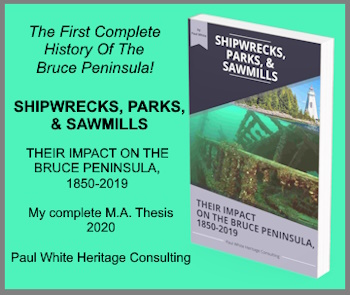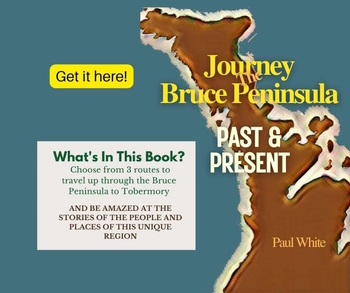Sailing Stories:
The Captain Who Smelled His Way Into Port
Sailing Stories: The Captain Who Smelled his Way into Port details how pioneer seamen on Georgian Bay safely sailed rough waters without the aid of the modern technological tools so readily used by today's mariners.
Sailing on Georgian Bay can be an enjoyable event.
The beautiful blue of the water, the scenic landscape, the irregularity of the shoreline, the towering cliffs where the escarpment juts out towards the water and the many islands which abound and offer safe haven from treacherous weather provide the sailor and traveller alike, with a panorama that calms the spirit and makes each hour on the water a pleasurable experience.
However, bad weather can instantly turn this Eden of beauty and tranquillity into a tomb of death and destruction.
Before the construction of roads and railroads, Georgian Bay provided Owen Sound with its only connection with the outside world.
Consequently, in the early days, as the month of November came to an end and the holiday season approached, Georgian Bay witnessed a frantic attempt by merchants and citizens of Owen Sound to ship out the season's produce and to receive the goods necessary to sustain the community during the coming months of isolation due to the freeze up of Georgian Bay.
As weather became wintrier and the waters more dangerous, the crews of the vessels took more risks as they defied nature and strove to bring the last supplies of the year to the out ports such as Owen Sound.
Tragically lives were lost as ships succumbed to the wintry wrath of the Bay. Sailors were more vulnerable than the today's travellers. They did not have sophisticated weather warning systems and often relied upon only their intuition and skills. Unfortunately, this was often not enough and many disasters occurred and families suffered through the holiday season mourning the loss of a father, son or brother.
Before modern communication technologies made it possible for tracking and forecasting weather conditions, Georgian Bay sea captains kept weather journals or diaries. These logs were extremely detailed reports of daily weather patterns that were encountered.
Using these observations and their sailing experience the mariners, hoped to be able to recognize and predict quickly coming storms in order to either seek refuge or make other plans to enable their vessel to ride out the bad weather.
As mariners learned to use their experience and their wits, the results of their often heroic actions led to many great sailing stories, many of which continue to told and told again.
The dangers that weather presented to Great Lakes shipping led to the establishment of a national weather service in 1871. In fact, the first storm warning for the Great Lakes was issued in early November 1870. However, most sea captains viewed the new technology with disdain, preferring to rely on their experience, intuition and their own weather journals.
One of my Favourite Sailing Stories
An example of the idiosyncrasies of Great Lakes captains can be seen in one of my favourite sailing stories.
The following story told by retired freighter captain Horace Beaton about a trip that he took as a passenger in 1927 on the "turkey trail" between Owen Sound and Sault Ste. Marie.
The second mate and the wheels-man were there. With the fog getting thicker, they started blowing the fog signals on the whistle. It wasn't long before the captain appeared and started walking back and forth in front of the wheelhouse. The second mate kept blowing the fog signal. A short time later the captain, walking back and forth in front of the open wheelhouse window said, "I say, I say, Buck, we are getting near Kegawog, I smell the cedars." After that, he walked to the ship's side, gave three pulls on the signal whistle to the engine room. This was to check the engine down. He then came back to the open window and said, "Get the lines ready to tie up, Buck." He had his watch in his hand, at the open window he said to the wheelsman, "Hard to port." The wheelsman swung the wheel around a few turns, turning the ship to the left. The Captain then said "Steady." The wheelsman steadied the ship on a compass heading. The fog was still so thick I'm sure you could not see over 50 feet. In a matter of three or four minutes, we pulled alongside the dock at Kegawog.
I told the foregoing sailing story to make a comparison of the early days with the modern equipment they have for navigating today. I have great respect for a captain like this with his watch and magnetic compass and his great wealth of knowledge. He could smell his way through the fog.
There are many sailing stories which detail the legends of the men who sailed the Great Lakes. As winter brings its curtain of ice and snow down on Georgian Bay, I often look out and try and imagine the frenzy of this time of year more than a century ago as the ships entered and departed their port with the final shipments of the season. My admiration for their courage and strength grows as I feel the temperature dropping and see the blue of the water growing darker until it is almost black.
Something else that makes this one of my favourite sailing stories is the fact that on the Monday morning after my story about the Captain who smelled his way into port appeared in the local newspaper, I received a telephone call. The lady's voice on the phone said, "Mr. White, I am the daughter of the Captain who smelled his way into port!"
After chatting for a few minutes we said good-bye. I have never forgotten that telephone call or the story. I realized that behind every story there are proud family members delighted to see their loved-one's exploits in print!
Georgian Bay Shipping
List of Lighthouses on the Great Lakes: If you have names and/or pictures of Great Lakes Lighthouses please submit them along with details of their location.
Georgian Bay Ships: A List of all the ships that sailed on Georgian Bay until the 1960s. This list is not complete. If you know of a ship that sailed the waters of Georgian Bay please contact me with information about that vessel, and, if you have a picture that I could post with it, that would be much appreciated.
1885: A Memorable Summer Job for Owen Sound teenage boys on the Great Lakes would have historic importance, not mention a possible exciting career opportunity.
Hindman Transportation Company was a well-known Great Lakes shipping company for many years. Here you will find pictures of many of the Hindman ships
Owen Sound Harbour – A Photographic History, by Robert A. Cotton is a book that interests my historiographical curiosity.
Commercial Great Lakes Fishing It is probably safe to suggest that the commercial fishing industry was an important part of the early growth of this region.
A Georgian Bay fishing vacation has long been a popular attraction in the Bruce Peninsula region. During fishing derbies, the regional waterways are dotted with fishing boats of all shapes and sizes.
The Georgian Bay Mackinaw, designed by William Watts of Collingwood is an example of a Georgian Bay innovator creating a vessel to service the needs local mariners.
Great Lakes fishing is an asset that is protected and developed, not only for its economic potential but also for those who just enjoy spending a day by the side of a river or in small fishing boats trying to catch “the big one”!
Great Lakes Fishing History is not without its controversy. The impact of the fishing industry was such that it played an important role in the development of communities along the Georgian Bay and Lake Huron shoreline.
Georgian Bay Travel Before the Winter Freeze-Up could be a dangerous time for mariners in the early years in this region.
A Harbinger of Spring on the Great Lakes in pioneer times, was the eagerly awaited news that a lighthouse had been lit and shipping traffic could begin sailing from port to port.
Lumber Hookers Lumber hookers and tugs were an important innovation to improve the transportation of lumber on Georgian Bay.
Mapmakers on Georgian Bay were also explorers. They mapped the Georgina Bay shoreline noting safe harbours, dangerous reefs and other guides for sailors and pioneer settlers looking for a place to call home.
Paddling Georgian Bay & Pondering: traversing parts of this great waterway in a canoe leads one to wonder about the ships of a bygone era battling the rough seas they encountered.
Parry Sound Shipping History: The Parry Sound area has always been connected to the southern regions of the Province of Ontario by a system of good roads. Or has it?
Parry Sound’s shipping history 2 is more than the tragic sinking of the Waubuno or the later catastrophe surrounding the sinking of the Asia.
Sailing Season Closing: A Frantic Time on Peninsula as ships raced from port to port delivering and picking up passengers and produce before the waterways froze.
Ship Captain Andrew Port was not only a dynamic and brave Georgian Bay mariner, he was a personal favourite historical character of mine.
Ships Stuck in Ice: The Oak Glen was icebound in 1996 but this sailing hazard has been impacting vessels on Georgian Bay since the beginning of time.
Lake Huron shipwrecks, the Hibou often occurred in the Georgian Bay region of that Great Lake due to the often violent waters that could strike unsuspecting vessels like the Hibou.
Shipwrecks: The "Asia" wrecked off the eastern coast of Georgian Bay taking all but two of the more than 100 passengers to a watery grave.
Masters, Mates, and Pilots Association created its first Canadian chapter on Georgian Bay, providing maritime safety education, and other seafaring issues to better inform its membership.
Pioneer Travel Aboard the Fly Tells the story of a sailing vessel as the tenuous link between survival and death in a pioneer settlement in the 1840's in Upper Canada.
Sailing Stories: the Captain Who Smelled his way into Port The Captain Who Smelled his Way into Port details how pioneer seamen on Georgian Bay safely sailed the rough waters without the aid of the modern technological tools so readily used by today's mariners.
Sailing Story: The Voyage of the Prince Alfred the incredible voyage of the Prince Alfred, fraught with danger for both vessel and the crew in the winter of 1880.
Shipbuilding As the southern Georgian Bay region became more populated shipping traffic increased to meet the needs of an expanding market place.
The Summer of 1844 was No Picnic for the early settlers in the pioneer area near what would become Owen Sound on Georgian Bay.
The CPR Grain Elevator Fire of 1911 spelled the end of Owen Sound's role as the eastern terminus of the CPR Great Lakes Fleet.
Georgian Bay shipping occurred long before the first Europeans paddled these waters. But the fur and timber trades opened Georgian Bay to shipping in a big way!
- History Articles ›
- Georgian Bay Shipping ›
- Sailing Stories: The Captain Who Smelled His Way Into Port





